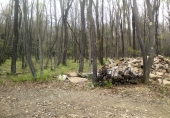




Thekla McDaniels wrote:Maybe I am repeating what I said here, maybe I said it elsewhere, but I once used an auger to drill 12 inch diameter post holes almost 4 feet deep. I scratched and abraded the polished sides, filled the holes with wood chips…
If nothing else, it increased the surface area for water to penetrate, and the wood chips provided habitat…
I hope it’s a fun project for you…

 1
1




Kris Nelson wrote:
Thekla McDaniels wrote:Maybe I am repeating what I said here, maybe I said it elsewhere, but I once used an auger to drill 12 inch diameter post holes almost 4 feet deep. I scratched and abraded the polished sides, filled the holes with wood chips…
If nothing else, it increased the surface area for water to penetrate, and the wood chips provided habitat…
I hope it’s a fun project for you…
Interesting, put them in vertically filled with chips to absorb then turn to organic matter. It would make the water go away quicker, hmmm, so these are the pipes with holes, but instead of horizontally, you put them in vertically? Or what are these post holes? I'm curious to get a full picture of what you did
Visit Redhawk's soil series: https://permies.com/wiki/redhawk-soil
How permies.com works: https://permies.com/wiki/34193/permies-works-links-threads




Jay Angler wrote:If you did a layout plan for garden beds and drilled a line of these holes 3-5 ft apart up-slope from the beds, there's a good chance they'd keep the beds dryer by infiltrating the rain, but the deep water, would hold the moisture during dry spells reducing the need to water.

 1
1




Jay Angler wrote:
Kris Nelson wrote:
Thekla McDaniels wrote:Maybe I am repeating what I said here, maybe I said it elsewhere, but I once used an auger to drill 12 inch diameter post holes almost 4 feet deep. I scratched and abraded the polished sides, filled the holes with wood chips…
If nothing else, it increased the surface area for water to penetrate, and the wood chips provided habitat…
I hope it’s a fun project for you…
Interesting, put them in vertically filled with chips to absorb then turn to organic matter. It would make the water go away quicker, hmmm, so these are the pipes with holes, but instead of horizontally, you put them in vertically? Or what are these post holes? I'm curious to get a full picture of what you did
I've read of this concept and do a variation of it. Essentially, you're just digging a hole which water can fill up, but to stop if from collapsing, you fill it with whatever biodegradable material you can access cheaply. I have too many rocks on my land to use a post-hole digger to do this. I dig a shallower, larger diameter hole and fill it with punky wood, veggie scraps, dead animals, animal bedding etc. This attracts free-range worms which help to loosen the surrounding clay and biodegrade the fill. I top up the fill when I see it getting below grade. This does wonders in my dry summers for keeping young trees alive if I build them 3-6 ft from the baby tree.
If you did a layout plan for garden beds and drilled a line of these holes 3-5 ft apart up-slope from the beds, there's a good chance they'd keep the beds dryer by infiltrating the rain, but the deep water, would hold the moisture during dry spells reducing the need to water.
Also, with heavy clay, I'd be very careful with tilling, unless I'm using the tiller to incorporate organic matter like fall leaves or wood chips. My friend with heavy clay soil tills without adding carbon and it tends to turn into concrete.
When in doubt, doubt the doubt.
 1
1




Michael Fundaro wrote:]
If you could space them evenly when you will them with wood chips and top soil you could plant something in each hole. Even if you don't till in wood chips and just do the top soil these holes would allow the roots to go deeper, faster.
And, is there something you could use the clay for elsewhere? Making berms, a raised circle around trees to hold water when you do have to water in the dry times, making pottery? Just a thought.
 2
2




Yes, when I have done this, the 'compost hole' has been 3-5 feet away from the plant - the idea is to encourage the roots to travel through the clay and take any goodies they want, but not to have them growing in it. I can easily imagine water pooling in the compost hole in some clay soils and drowning the plant roots. That said, in places I've used a lot of wood-chips, I will sometimes water with 10% Liquid Gold (human urine) to help with the nitrogen issue. I don't do that anywhere that the run-off could contaminate ground water - there has to be plants/mycorrhizae nearby that will access the wood-chips and utilize that nitrogen.Jenny Wright wrote: I had issues trying this though I planted gooseberries and currants, not trees. My plants stayed alive but were stunted and didn't grow. I suspect it had to do with the woodchips and stuff breaking down and starving them of nitrogen. Either that, or maybe water just sat too long in the holes.? I finally dug them up after a few years and moved them to new homes.
Visit Redhawk's soil series: https://permies.com/wiki/redhawk-soil
How permies.com works: https://permies.com/wiki/34193/permies-works-links-threads
 4
4




Kris Nelson wrote:
Interesting, put them in vertically filled with chips to absorb then turn to organic matter. It would make the water go away quicker, hmmm, so these are the pipes with holes, but instead of horizontally, you put them in vertically? Or what are these post holes? I'm curious to get a full picture of what you did
Best luck: satisfaction
Greatest curse, greed
 1
1




Bless your Family,
Mike




Michael Moreken wrote:Create a small pool in lowest area. Rack up cut stuff and compost it.
I bury all paper that comes in mail, keep out plastic windows, and shiny ads. I bury them in the yard to build up soil.
get garbage cans, or plastic ones, drill 3 one inch holes in bottom of trash cans. Load up with 100% greens or all the brown material, put lid on and park in sun. Easy composting.
 2
2




Kris Nelson wrote:I have two small fields. The soil is quite heavy in clay.
"I live on Earth at present, and I don't know what I am.I know that I am not a category.I am not a thing—a noun.I seem to be a verb, an evolutionary process—an integral function of the universe."
Buckminster Fuller




Home and Small Farm Hydropoinics: https://hydroponics.snowcron.com
 1
1




Erik van Lennep wrote:Just throwing in my 2 cents, after reading through this thread.
Thanks for posting the 'problem', it has inspired some very interesting exchange! (Thus already productive)
Were it my patch, I would dig the cat tail bog deeper and make an actual pond there. Since it's a relatively small area in total, I would use the drier time over the summer to regrade the whole field while digging the pond, and create a stronger slope towards the pond, while spreading the soil removed to make it deeper back over the surrounding field.
That would enable me to have a nice biodiversity focus while planting something like arrowroot on the margins...I could leave or dig and eat the roots as I chose later. I would make at least part of the pond margin into a boggy zone that I would then plant with cranberries and blueberries. Maybe some elderberries.
I'd also get a few dumps of wood chips to mix into the clay while the regrading operation was happening.
If I removed the willow, I would be sure to chip it so the pieces dry and die faster. I would not put any logs or branches into my hugel beds until they were definitely dry enough not to resprout.




 I'd have to see how the trenches/ditches and ponds work out to keep the water away first I think.
I'd have to see how the trenches/ditches and ponds work out to keep the water away first I think.



Kris Nelson wrote:
 I'd have to see how the trenches/ditches and ponds work out to keep the water away first I think.
I'd have to see how the trenches/ditches and ponds work out to keep the water away first I think.
"I live on Earth at present, and I don't know what I am.I know that I am not a category.I am not a thing—a noun.I seem to be a verb, an evolutionary process—an integral function of the universe."
Buckminster Fuller
 2
2




You can eat anything once, sometimes more than once.

|
Because there is no spoon. Just a tiny ad:
Learn Permaculture through a little hard work
https://wheaton-labs.com/bootcamp
|





